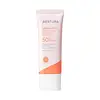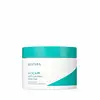What's inside
What's inside
 Key Ingredients
Key Ingredients

 Benefits
Benefits

 Concerns
Concerns

No concerns
 Ingredients Side-by-side
Ingredients Side-by-side

Water
Skin ConditioningButylene Glycol
HumectantGlycerin
HumectantDiethylamino Hydroxybenzoyl Hexyl Benzoate
UV FilterHomosalate
Skin ConditioningEthylhexyl Salicylate
UV AbsorberMethyl Trimethicone
Skin ConditioningButyloctyl Salicylate
Skin ConditioningTitanium Dioxide
Cosmetic ColorantC12-15 Alkyl Benzoate
AntimicrobialBis-Ethylhexyloxyphenol Methoxyphenyl Triazine
Skin ConditioningPolysilicone-15
UV FilterCI 77891
Cosmetic Colorant1,2-Hexanediol
Skin ConditioningCetearyl Alcohol
EmollientSilica
AbrasivePoly C10-30 Alkyl Acrylate
Emulsion StabilisingHydroxyethyl Acrylate/Sodium Acryloyldimethyl Taurate Copolymer
Emulsion StabilisingAluminum Stearate
Cosmetic ColorantAlumina
AbrasiveStearic Acid
CleansingPolyhydroxystearic Acid
EmulsifyingAcrylates/C10-30 Alkyl Acrylate Crosspolymer
Emulsion StabilisingAllantoin
Skin ConditioningGlyceryl Stearates
EmollientHydrogenated Lecithin
EmulsifyingCaprylyl Glycol
EmollientEthylhexylglycerin
Skin ConditioningTromethamine
BufferingAluminum Hydroxide Oxide
AntimicrobialPolyglyceryl-3 Methylglucose Distearate
EmulsifyingPalmitic Acid
EmollientDisodium EDTA
Trimethoxycaprylylsilane
SmoothingSorbitan Isostearate
EmulsifyingCI 77491
Cosmetic ColorantHydrolyzed Hyaluronic Acid
HumectantCeramide NP
Skin ConditioningCI 77492
Cosmetic ColorantMyristic Acid
CleansingLauric Acid
CleansingTocopherol
AntioxidantWater, Butylene Glycol, Glycerin, Diethylamino Hydroxybenzoyl Hexyl Benzoate, Homosalate, Ethylhexyl Salicylate, Methyl Trimethicone, Butyloctyl Salicylate, Titanium Dioxide, C12-15 Alkyl Benzoate, Bis-Ethylhexyloxyphenol Methoxyphenyl Triazine, Polysilicone-15, CI 77891, 1,2-Hexanediol, Cetearyl Alcohol, Silica, Poly C10-30 Alkyl Acrylate, Hydroxyethyl Acrylate/Sodium Acryloyldimethyl Taurate Copolymer, Aluminum Stearate, Alumina, Stearic Acid, Polyhydroxystearic Acid, Acrylates/C10-30 Alkyl Acrylate Crosspolymer, Allantoin, Glyceryl Stearates, Hydrogenated Lecithin, Caprylyl Glycol, Ethylhexylglycerin, Tromethamine, Aluminum Hydroxide Oxide, Polyglyceryl-3 Methylglucose Distearate, Palmitic Acid, Disodium EDTA, Trimethoxycaprylylsilane, Sorbitan Isostearate, CI 77491, Hydrolyzed Hyaluronic Acid, Ceramide NP, CI 77492, Myristic Acid, Lauric Acid, Tocopherol
Water
Skin ConditioningGlycerin
HumectantButylene Glycol
Humectant1,2-Hexanediol
Skin ConditioningCaprylic/Capric Triglyceride
MaskingDibutyl Adipate
EmollientHydrogenated Lecithin
EmulsifyingAllantoin
Skin ConditioningAmmonium Acryloyldimethyltaurate/Vp Copolymer
Cholesterol
EmollientPropanediol
SolventEthylhexylglycerin
Skin ConditioningMadecassoside
AntioxidantPhytosterols
Skin ConditioningBeta-Glucan
Skin ConditioningTocopherol
Antioxidant
 Reviews
Reviews

Ingredients Explained
These ingredients are found in both products.
Ingredients higher up in an ingredient list are typically present in a larger amount.
1,2-Hexanediol is a synthetic liquid and another multi-functional powerhouse.
It is a:
- Humectant, drawing moisture into the skin
- Emollient, helping to soften skin
- Solvent, dispersing and stabilizing formulas
- Preservative booster, enhancing the antimicrobial activity of other preservatives
Allantoin is a soothing ingredient known for its protective and moisturizingg properties. Because of this, it is often added to products with strong active ingredients.
Studies show higher concentrations of this ingredient can promote wound healing.
Though it can be derived from the comfrey plant, allantoin is produced synthetically for cosmetic products to ensure purity.
Learn more about AllantoinButylene Glycol (or BG) is used within cosmetic products for a few different reasons:
Overall, Butylene Glycol is a safe and well-rounded ingredient that works well with other ingredients.
Though this ingredient works well with most skin types, some people with sensitive skin may experience a reaction such as allergic rashes, closed comedones, or itchiness.
Learn more about Butylene GlycolEthylhexylglycerin (we can't pronounce this either) is commonly used as a preservative and skin softener. It is derived from glyceryl.
You might see Ethylhexylglycerin often paired with other preservatives such as phenoxyethanol. Ethylhexylglycerin has been found to increase the effectiveness of these other preservatives.
Glycerin is already naturally found in your skin. It helps moisturize and protect your skin.
A study from 2016 found glycerin to be more effective as a humectant than AHAs and hyaluronic acid.
As a humectant, it helps the skin stay hydrated by pulling moisture to your skin. The low molecular weight of glycerin allows it to pull moisture into the deeper layers of your skin.
Hydrated skin improves your skin barrier; Your skin barrier helps protect against irritants and bacteria.
Glycerin has also been found to have antimicrobial and antiviral properties. Due to these properties, glycerin is often used in wound and burn treatments.
In cosmetics, glycerin is usually derived from plants such as soybean or palm. However, it can also be sourced from animals, such as tallow or animal fat.
This ingredient is organic, colorless, odorless, and non-toxic.
Glycerin is the name for this ingredient in American English. British English uses Glycerol/Glycerine.
Learn more about GlycerinHydrogenated Lecithin is created from the hydrogenation of lecithin (a group of phospholipids). Hydrogenation is a chemical reaction between hydrogen and another element.
This ingredient is an emollient and emulsifier. As an emollient, it helps soften skin by trapping moisture within. As an emulsifier, it prevents oil and water ingredients from separating.
Tocopherol (also known as Vitamin E) is a common antioxidant used to help protect the skin from free-radicals and strengthen the skin barrier. It's also fat soluble - this means our skin is great at absorbing it.
Vitamin E also helps keep your natural skin lipids healthy. Your lipid skin barrier naturally consists of lipids, ceramides, and fatty acids. Vitamin E offers extra protection for your skin’s lipid barrier, keeping your skin healthy and nourished.
Another benefit is a bit of UV protection. Vitamin E helps reduce the damage caused by UVB rays. (It should not replace your sunscreen). Combining it with Vitamin C can decrease sunburned cells and hyperpigmentation after UV exposure.
You might have noticed Vitamin E + C often paired together. This is because it is great at stabilizing Vitamin C. Using the two together helps increase the effectiveness of both ingredients.
There are often claims that Vitamin E can reduce/prevent scarring, but these claims haven't been confirmed by scientific research.
Learn more about TocopherolWater. It's the most common cosmetic ingredient of all. You'll usually see it at the top of ingredient lists, meaning that it makes up the largest part of the product.
So why is it so popular? Water most often acts as a solvent - this means that it helps dissolve other ingredients into the formulation.
You'll also recognize water as that liquid we all need to stay alive. If you see this, drink a glass of water. Stay hydrated!
Learn more about Water